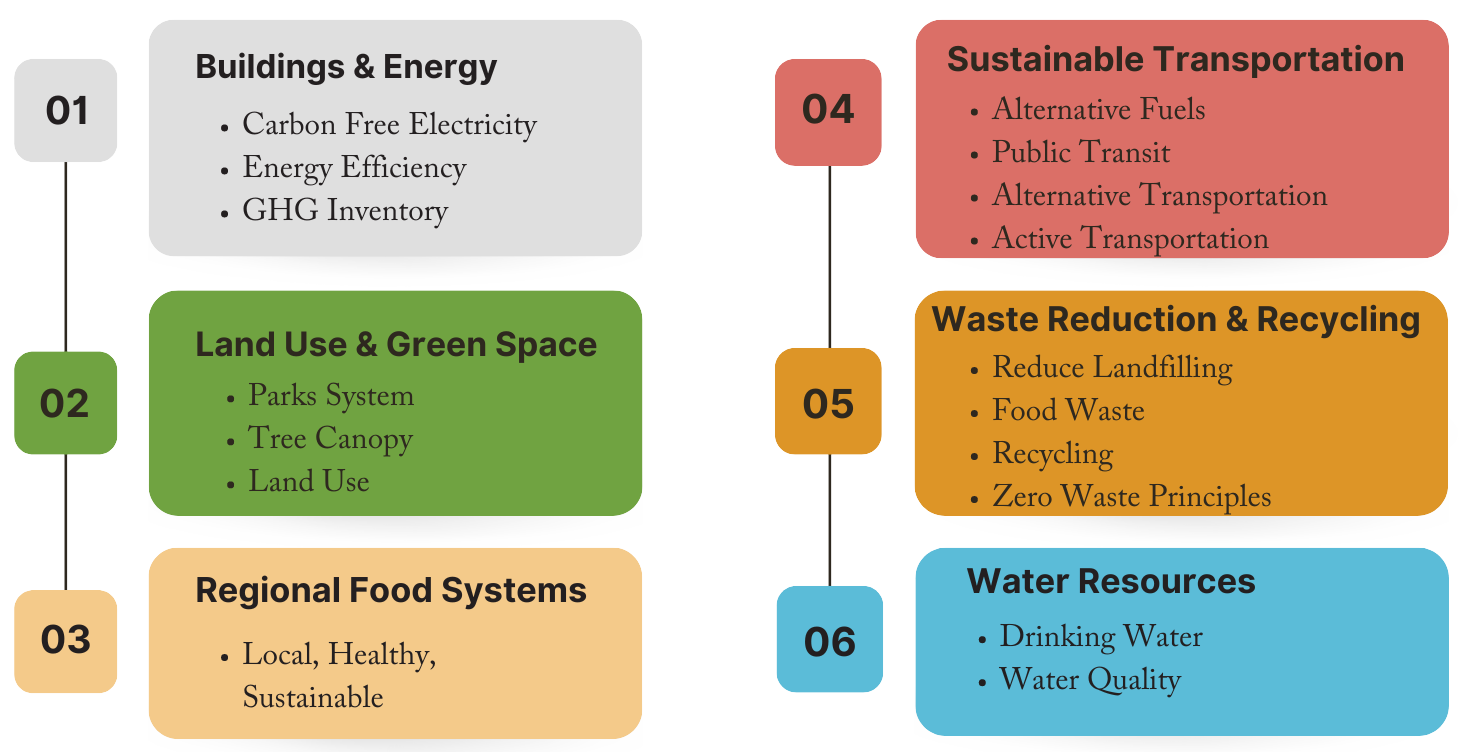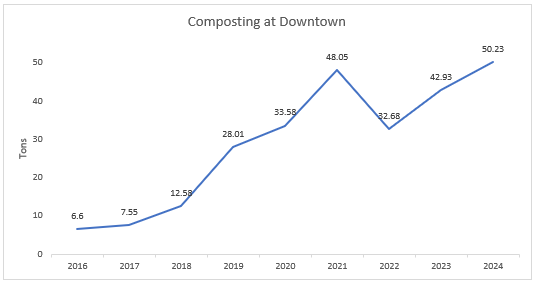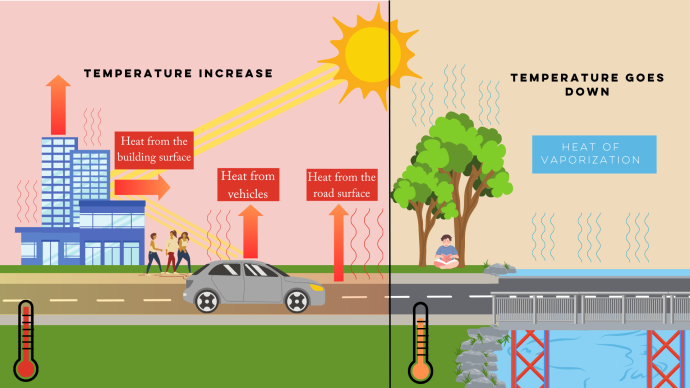The Environmental Action Plan (EAP) is a guide for city leaders, staff, and members of the community to implement sustainability visions and principles. To date, the City of Harrisonburg has taken steps to address the quality and care of our natural resources; however, the latest science indicates that more ambitious actions are required to mitigate the impacts of environmental degradation and the changing climate that will affect our community’s health, economy, and well-being. Adopting and implementing the EAP helps the City support global targets for a stable climate and a resilient community.
- Focus Areas within the Environment Action Plan
The Environmental Action Plan (EAP) is a guide for City leaders, staff and the community to implement sustainability visions and principles.
The development of the EAP is divided in three phases (1, 2, and 3). The EAP document represents Phase 1 and describes goals, co-benefits, and strategies, and identifies tasks and responsible parties (such as a city department, private businesses, community organizations, or individuals). Phase 2 focuses on establishing indicators for the
 strategies outlined in Phase 1 to evaluate progress towards targets set in Phase 3. Phase 1 of the EAP was adopted by City Council on January 14, 2020. The plan includes recommended policy changes in the public sector and incentives in the private sector, as well as recommended actions for both the public and private sectors. The six focus areas are, Buildings and Energy, Land Use and Green Space, Regional Food Systems, Sustainable Transportation, Waste Reduction and Recycling, and Water Resources.
strategies outlined in Phase 1 to evaluate progress towards targets set in Phase 3. Phase 1 of the EAP was adopted by City Council on January 14, 2020. The plan includes recommended policy changes in the public sector and incentives in the private sector, as well as recommended actions for both the public and private sectors. The six focus areas are, Buildings and Energy, Land Use and Green Space, Regional Food Systems, Sustainable Transportation, Waste Reduction and Recycling, and Water Resources.Resource Documents:
Environmental Action Plan (EAP) [1.59MB]
Environmental Action Plan Focus Area 4 Phase 2 and 3 Addendum [904.88KB]
- Community Goals within the Environmental Action Plan
The overarching principle of community goals is to empower our entire community to work together to slow the effects of climate change.
The Community Goals are:
- Reduce Greenhouse Gas Emissions
- Effective, Affordable and Equitable Transition
- Clean Renewable Energy
- Actions with Intersectional Benefits
- Public Engagement and Education
- Local Resiliency and Adaptation
Community Goals Addendum [196KB]
- Greenhouse Gas Inventory for the City of Harrisonburg
Why Conduct an Inventory:
The Environmental Action Plan identifies completing an inventory as an important strategy towards the second Guiding Goal to reduce overall, community-wide greenhouse gas emissions. Inventories help us understand where our emissions are coming from. In addition, conducting annual inventories helps us to compare each subsequent year to our baseline year of 2016. This allows us to see the impacts in terms of increased or decreased emissions from various actions, policies, behavioral changes, and the makeup of our energy sources. Annual inventories help to hold our entire community accountable and to allow us to see, understand, and change behavior based on the trends we see.
Understanding our Greenhouse Gas Inventory and Analysis Process
Greenhouse Gas (GHG) inventories are developed using established methodologies to provide an accurate picture of emissions for a specific time period. Our approach follows recognized standards and protocols, using ICLEI’s ClearPath online software, a tool for community-scale GHG emissions management. This analysis applies both the 100-year and 20-year global warming potentials (GWP) from the latest version of the Intergovernmental Panel on Climate Change (IPCC) Assessment Report (ARx). We use calendar year 2016 as the baseline for comparing all future inventory years. Each inventory report involves collecting, processing, and analyzing data inputs—such as energy consumption, waste generation, and transportation metrics—and calculating emissions based on these parameters.
As methodologies, data sources, and technologies improve, so does our approach. Each year, we may refine our data collection methods or calculation procedures to increase accuracy. Due to these updates, comparisons between reports from different years require careful consideration, as changes in methodology or data inputs can impact reported emissions. For a meaningful analysis, adjustments are documented within each report, and emissions for previous years are recalculated when necessary to allow consistent comparisons. Refer to the Analysis Results section for tables summarizing emissions across years, which account for any changes in methodology to ensure data comparability.
2016/19 Harrisonburg GHG Emissions Report (September 2021) [1.56MB]
2021 Harrisonburg GHG Emissions Report [4.39MB]
- Solar Energy
Electricity generation and use is one of the major sources of greenhouse gas (GHG) emissions in the United States and Harrisonburg is no exception. There is growing recognition of the urgency of significantly reducing GHG emissions. State and local governments in Virginia and throughout the United States are responding with a variety of initiatives for renewable, carbon free, carbon neutral, net-zero, and green energy expansion and innovation.
Building
Solar System Size (kW)
Year Installed
Bluestone Elementary 340 2023 HCPS Central Office 35.1 2023 Public Works Administrative Building 91 2024 Turner Pavilion 35
TBDNavigation Center
TBD
2024Fire Station 5
83
2025Total kW Solar:
584.1 Learn more about Solar Energy Resources within the City.

Current SolSmart Designation: Silver (2023)
- Sustainable Transportation
The City of Harrisonburg seeks to develop and maintain a safe and convenient transportation system serving all modes of travel, including driving, walking, biking, public transportation, ride sharing, and future technologies that serve the transportation needs of the community. The primary environmental benefit of sustainable transportation is the reduction of pollutants, such as greenhouse gases, which are released into the atmosphere. Public infrastructure has been developed to serve primarily gasoline and diesel single occupancy vehicles and truck freight for many decades. In the future, new forms of transportation and technology will become more common. Concepts of multimodal, microtransit, and active transportation are increasingly being used in transportation planning.
Transportation Projects Webpage
Fleet EVs
Vehicle Type
Quantity
Chevy Bolt EUV 2 Ford F-150 Lightening 3 International CE Series EV school buses 5 Fleet E-Bikes
Quantity
Como 1 Globe Haul 1 - Waste Reduction
Composting is a great way to keep organic materials out of refuse, which diverts waste from the landfill and also cuts down on the potential for "refuse juice" to spill on the street and enter the storm sewer system. Although the City does not provide curbside collection of compost, did you know that there is a public compost drop-off location in Harrisonburg?

- Urban Heat Island Study
According to the Environmental Protection Agency (EPA), heat islands are urbanized areas that experience higher temperatures than outlying areas. Structures such as buildings, roads, and other infrastructure absorb and re-emit the sun’s heat more than natural landscapes such as forests and water bodies. Urban areas, where these structures are highly concentrated and greenery is limited, become “islands” of higher temperatures relative to outlying areas. Daytime temperatures in urban areas can be several degrees higher than temperatures in outlying areas. Temperature differences can persist throughout the nighttime as well.
Heat Watch VFIC 2021 Report [25MB]
View: Urban Heat Island Map

Tree Canopy Analysis Maps
The City of Harrisonburg received services from the Green Infrastructure Center Inc. (GIC) through the Virginia Department of Forestry’s Community Forest Revitalization Program. GIC provided an updated tree canopy analysis and recommended goals and strategies for the city’s urban forestry program.
View the Tree Canopy Study Maps
NASA DEVELOP Project
To better understand these trends, NASA DEVELOP partnered with the City of Harrisonburg Public Works Department to map land cover and land surface temperature changes from 2014–2024. Using satellite and aerial imagery, the team found that canopy cover declined by about 5.5% (617 acres) while impervious surfaces increased by about 2% (224 acres). The largest shifts occurred between 2021 and 2023, with tree loss and new development correlating with rising land surface temperatures.
These findings will help Public Works identify priority areas for tree planting and guide broader resiliency efforts across the city.
Review the Final Poster
Review the Final Report
Watch the video about the results on our YouTube page!
- Projected Climatic Changes
"Climate" is often confused with "weather." Weather is short-lived, day-to-day conditions. Climate is long-term trends over time, typically 20 years or more. Weather can be related to a "mood" whereas Climate would be related to "a personality".
- In 2022, Fairfax County completed an analysis of the projected climate conditions for 2050 and 2085 in Fairfax County, Virginia. While the report was made specifically for Fairfax County, the results are still applicable to Harrisonburg.
- Fairfax County's Climate Projections Report presents future conditions under two greenhouse (GHG) scenarios: (1) a moderate warming future scenario, Representative Concentration Pathway (RCP) 4.5, where global GHG emissions peak around 2040 and then, through climate policies, stabilize at around 540 parts per million (ppm) by 2100 (referred to "lower emissions" in this report), and (2) a high future warming scenario, RCP8.5, where there is little curbing of emissions and concentrations continue to increase rapidly reaching about 940 ppm by 2100 (referred to as "higher emissions" in the report).
- Visit Fairfax County's Resilient Fairfax Website for more information.

- Environmental Performance Standards Advisory Committee
The Environmental Performance Standards Advisory Committee (EPSAC) advises Harrisonburg City Council and staff on developing, monitoring, and implementing the Environmental Action Plan (EAP), as well as other community environmental issues referred to the Committee. It also supports public outreach and education to advance environmental sustainability.

